|
We Like Aeroplane Jelly
Few foods have become as synonymous with Australian culture as
Aeroplane Jelly, a simple yet delicious desert treat which has been
perennially popular with generations of adults and children, an
iconic product like Vegemite or Fosters Lager.
Meet The Inventor
Aeroplane Jelly was invented by Adolphus Appleroth (1886-1952), born
Adolphus Herbert Frederick Norman Appleroth in Melbourne, third
surviving child of William Appleroth, a Russian-born driver and wife
Emma, daughter of a Melbourne wine merchant.
The family moved to Sydney where Bert (Adolphus) began work in 1902
as a messenger boy at the Lipton’s Tea agency. He then took a job as
a tram conductor.
Bert began experimenting with mixtures of gelatine and sugar in the
bath in his parents’ home at Paddington, and hawked the jelly
crystals that he produced door-to-door, using trams as transport.
Leaving the tramways in 1917, Appleroth rented premises at 10
shillings a week in which to manufacture his jelly crystals.
[1]
He never manufactured his own gelatine - the process is long and
complicated as we will see later in the article. Instead, he
purchased gelatine in powdered form from local and overseas
suppliers and reprocessed it to create his famous desert treat. He
marketed some jellies under the name "De-Luxe".
In 1926 he formed a company, Traders Ltd, and was joined by a
partner Albert Francis Lenertz (1891-1943) who became managing
director. The business operated from Sussex Street in the city
before moving to larger premises at Alice Street, Newtown, in 1927.
[1]
The Name
The advent of the business venture coincided with the birth of
aviation, not long after the Wright Brothers historic flight at
Kitty Hawk beach ushered in airmail making the world a smaller
place. This golden age, occurring in the 1920’s and 1930’s, was a
time of rapid advances in design ensuring commercial airlines began
large scale operations. Between the wars, people the world over were
entranced by flying machines and the feats of aviators like Charles
Lindbergh, Sir Charles Kingsford Smith and Amelia Earhart, so it
isn’t surprising that Appleroth capitalized on that mania by naming
his new product "Aeroplane Jelly".
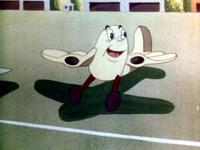
The Song/Jingle
In 1930 Albert Lenertz (1891-1943), Appleroth’s business
partner, wrote the words and music of the Aeroplane Jelly song
based on a less successful patriotic jingle he had written
celebrating the Prime Ministership of William Hughes (1862-1952)
who at the time was Australia’s longest serving Prime Minister;
it would become the longest running advertising jingle in
Australian history. They were the first Australian company to
fully harness the new promotional mediums of radio and cinema,
using the animated aeroplane "Berti" as the logo/mascot (named
after Appleroth) in advertisements run during movie
intermissions but it would be the jingle that would leave the
indelible mark on Australian culture, the airwaves saturated
with it for decades:
I’ve got a song that won’t take very
long,
Quite a good sort of note if I strike it.
It is something we eat, and I think it’s quite sweet,
And I know you are going to like it.
I like Aeroplane Jelly … Aeroplane Jelly for me,
I like it for dinner, I like it for tea,
A little each day is a good recipe.
The quality’s high as the name will imply,
And it’s made from pure fruits, one more good reason why
I like Aeroplane Jelly … Aeroplane Jelly for me.
"It was first recorded and
broadcast over the airways on Sydney radio station 2KY in 1930,
sung by Amy Rochelle, an actress who did child imitations. The
song was again recorded in 1938, sung by Joy King (1932-1996), a
five year old girl chosen via a competition, she made the jingle
her own.
Lenertz produced and announced radio programmes over Sydney
stations 2KY and 2SM, and used the song as the signature tune.
Eventually, the jingle was broadcast over commercial radio one
hundred times each day."[1]
The song is still in use today as a marketing jingle although
modern versions have subtle differences in wording to suit a
modern world. Few products in Australian history were as
intensely marketed as Aeroplane Jelly, in the 1930’s deliveries
of the jelly were made to country areas by brightly painted
Tiger Moths emblazoned with company logos which thrilled
children and resulted in masses of free publicity. While in
cinemas across the nation people were fed a steady diet of "Bertie"
promoting the product and its growing variety of flavours, which
in the post war years quickly infiltrated television.
Bet You Didn't Know This!
Adolphus Appleroth didn’t invent jelly as is popularly assumed,
powdered gelatine was invented in 1845 by American Peter Cooper,
however it wasn’t until 1895 when it became a desert, when a
cough syrup manufacturer developing a gelatine based dessert
called "Jell-O" which is still in production.
Although the making of jelly is simple, a matter of adding warm
water to a sachet of powder and leaving in a cool place to set,
there’s nothing simple about the production of gelatine.
Contrary to the jingle, it is not made from pure fruit, nothing
remotely close to it.
It starts with the soaking of cow hides or pig skins in a dilute
acid or lime solution. Pig or cow bones are degreased and soaked
in acid or lime to remove the calcium, the resulting soft tissue
is called ossein. The ossein is soaked in the same manner as the
hide or bone. This process partially hydrolyses the collagen
which is not water soluble prior to this step. The hide, skin or
bone is washed and cooked in hot water to extract the gelatine.
The extract is dried and ground to powder.
To make desserts, the gelatine is mixed with sugar and additives
like adipic and fumaric acids, sodium citrate and artificial
flavourings and colours. In a world where obesity is a growing
problem Aeroplane Jelly is a guilt free treat, possessing no fat
and a mere 64kj per 100gm serve.
The Girl on the Swing
A pivotal element in the success of the Aeroplane Jelly jingle
was its transference to the big and small screen. The
jingle had a life of its own on radio but to succeed on screen
it needed an enchanting human persona to hook people visually.
They got it in the form of a seven year old girl called Barbara
Llewellyn.
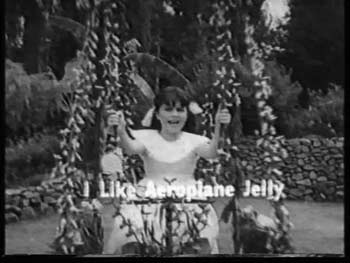
As a child Barbara caught the eye of the nation on the Jack
Davey Radio Show talent contest, one of the country’s most
popular programs broadcast simultaneously on TV and radio
compared by Jack Davey (1907-1959). The New Zealand born host
was Australia’s original "Mr Radio", people started their day
with his ‘Hi, Ho! Everybody!’ welcome to his popular breakfast
show. He had a string of popular game and talent shows, his
"Calling the Stars" was recorded at Sydney’s legendary Trocadero
Ballroom in front of a large audience and he soon became one of
the highest paid entertainers in Australia.
Just five at the time of her appearance on Davey’s show, Barbara
was the youngest contestant to reach the final and, as the last
contestant billeted to perform, she dozed off back stage only to
be woken by a stage manager when it was her turn to take to the
stage and sing. Undaunted, the little trooper marched out into
the glare of klieg lights, rubbed the sleep out of her eyes and
sang her way into the hearts of the studio and home audience,
sleepily waving goodbye with a yawn when done. It came as no
surprise she won, her prize a trip for two anywhere in
Australia, a fully decorated Christmas tree and a dolly almost
as big as she was.
Her heart warming performance caught the eye of casting agents
which resulted in her mother's phone ringing hot for weeks,
offers of film and TV work flooding in. Barbara’s childhood was
filled with work in commercials, documentaries, film and
theatre. Two years later Barbara became an Australian icon by
starring in the now famous Aeroplane Jelly television
commercial. She mimed the well-known Aeroplane Jelly jingle, and
was ever-after identified as The Girl on the Swing.
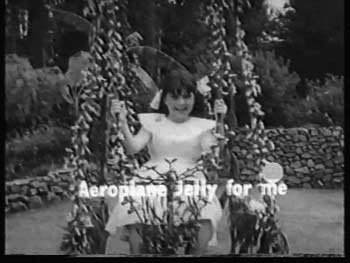
Soon after she won a role in the landmark UK/Australian movie
"The Sundowners" (1960) staring Deborah Kerr, Robert Mitchum,
Peter Ustinov and Chips Rafferty. Directed by Fred Zinnemann and
based on a novel by Jon Cleary, it depicted the lives of
itinerant sheep drovers in the depression era. One of the local
actors in the movie was Leonard Teale (1922-1994) who played a
shearer, it was the first time the two would work together but
certainly not the last. Teale would play her father in the hit
TV mini series "Seven Little Australians" thirteen years later
and her school principal in "Class of 74" soon after that, they
would remain the closest of friends.
Her next major role was on stage in the original Australian
production of ‘The Sound of Music’ at Sydney’s Tivoli Theatre,
playing Brigitta, one of the Von Trapp children. A musical based
on the memoir "The Story of the Trapp Family Singers" (1949) by
nun turned baroness Maria von Trapp, its fictionalised
adaptation by Howard Lindsay and Russel Crouse with music by
Rodgers & Hammerstein turning it into the mega hit ‘The Sound of
Music’ which premiered on Broadway on the 16th of November 1959
and was made into an Oscar winning movie starring Julie Andrews
in 1965.
With an impressive body of work behind her already she was
accepted as a student at The National Institute of Dramatic Art
[NIDA], Australia’s premier drama school, at the tender age of
17 and graduated in 1971 with a Bachelor of Dramatic Art
majoring in Acting. While a student she performed in numerous
stage productions, 30 years on she is still remembered in the
production of "Pier Gynt". Her graduation coincided with the
golden age of Australian television and she soon found her way
into what are regarded today as iconic examples of the craft,
including ABC TV’s international hit "Seven Little Australians"
(1973) - "Matlock Police" (1974) - "Class of ‘74" (1974) -
"Homicide" (1976) - "The Box" (1977) and "Young Ramsay"
(1977-78) to name a few.
The Whistling Boy
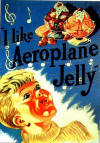 Jelly
promotions enabled several children to have a brush with
immortality, another familiar Aeroplane Jelly face is the ruddy
faced “Whistling Boy”. The face of Thomas "Tommy" Dawes, born in
1931 and presently living near Gosford, NSW. Jelly
promotions enabled several children to have a brush with
immortality, another familiar Aeroplane Jelly face is the ruddy
faced “Whistling Boy”. The face of Thomas "Tommy" Dawes, born in
1931 and presently living near Gosford, NSW.
With his singing teacher and mother's prompting, the seven year
old Tommy took part in the 1938 nationwide singing competition
that Joy King won. Tommy may not have won but he was a finalist
and he so impressed Mr Appleroth that an artists image of him
whistling the famous jingle was commissioned to illustrate jelly
packets.
“I always liked performing and I was mother’s pet so she put me
forward,” he said, “It was absolutely fantastic, I loved seeing
my picture and singing the song, my friends were all very
impressed.”
[2]
Thomas Dawes's face graced jelly packets and promotional
literature for over 40 years and to attract more boys to the
product they even had him record a male version of the famous
jingle.
“I got 10 guineas and a very nice onyx inkstand,” Thomas Dawes
told a Sun-Herald journalist in 2007, “other than that I haven’t
received a cent. I have never wanted any money from it, I’m not
that sort of person. I just like telling everyone that I’m the
Aeroplane Jelly boy.”
It must be said that 10 guineas was quite a substantial sum of
money in 1938 . It was the height of the Great Depression, with
26% unemployment and downward pressure on wages. The
Commonwealth Arbitration Court had cut all wages by 10% at the
onset of the Depression to lighten the burden on struggling
industry. What Tommy earned was the equivalent of five weeks
salary for a lucky, wage earning, adult male. Adolphus Appleroth
was generous with all his employees in those dark years.
After leaving school, Tommy worked in a factory before flying
helicopters in the Vietnam War. “That was hard, a few mates were
killed, it was scary stuff,” he said.
 Afterwards,
he performed on cruise ships before retiring, but still visits Afterwards,
he performed on cruise ships before retiring, but still visits
nursing homes and
entertains residents with the song. He has four daughters from
two marriages and six grandchildren, all of whom know about his
early brush with fame.
[2]
A Sad Goodbye and a New Beginning
By 1949, Appleroth’s factory had an annual turnover of £170,000,
a substantial sum at the time, his showmanship saw his jelly
become a national icon in his life time. A religious man he
donated large sums of money to charitable causes, a Freemason he
donated large sums to the Grand Lodge of NSW who have a display
dedicated to him at the Sydney Masonic Center. He was a man with
boundless energy and enthusiasm for his product and it wore him
out, he died of a heart attack at his Croydon home on July 17
1952 aged 66.
Adolphus Appleroth's company continued on without him, his
children and grand children running it with great success until
selling it 43 years later to McCormick Foods, a billion dollar
American multinational corporation founded in 1889 by 25 year
old Willoughby McCormick. The success of Aeroplane Jelly
continues to the present day, the global reach of McCormick
Foods giving the product a distribution network Appleroth could
only have dreamt of, his jelly now generating sales in excess of
10 million packets a year worldwide.
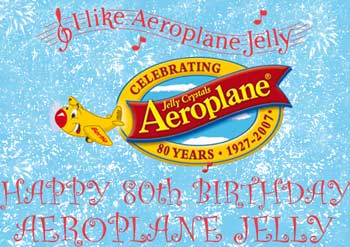
Bibliograhy
1. “Appleroth, Adolphus Herbert Frederick Norman (1886-1952)”,
by Paul Brunton, Australian Dictionary of Biography, Volume 13,
Melbourne University Press, 1993, pp 63-6.
2. ‘Whistling boy who took flight’, by Maxine Frith. The
Sun-Herald. 14.10.07
* Special thanks to McCormick Foods Australia.


Reviews
(applause received) 
Be
the first to review this article - click here.
|